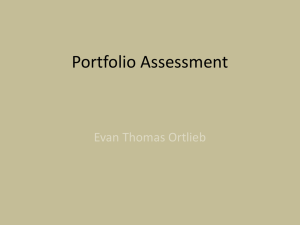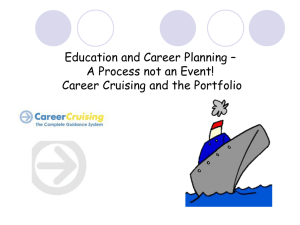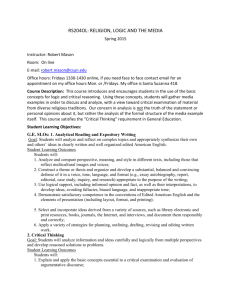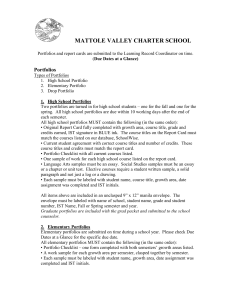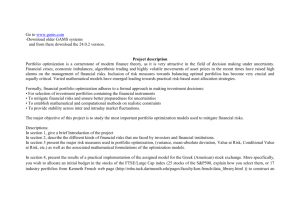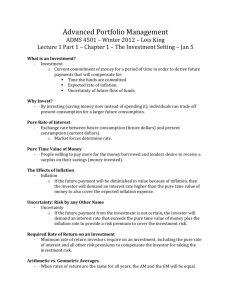File - Benjamin R. Mandel
advertisement
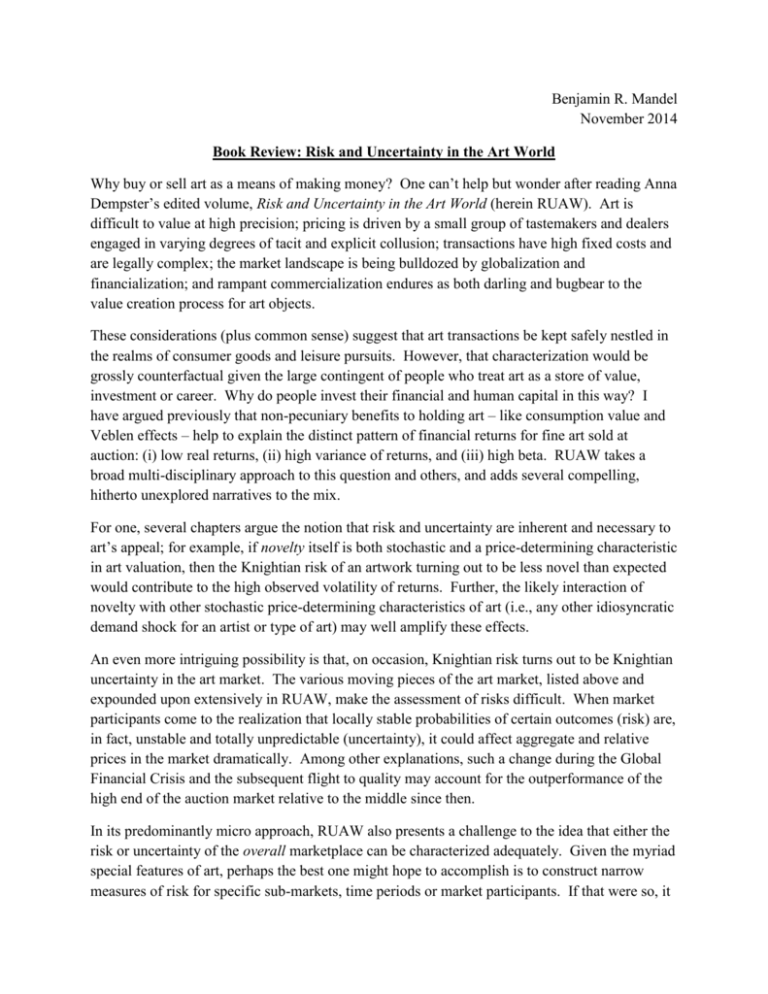
Benjamin R. Mandel November 2014 Book Review: Risk and Uncertainty in the Art World Why buy or sell art as a means of making money? One can’t help but wonder after reading Anna Dempster’s edited volume, Risk and Uncertainty in the Art World (herein RUAW). Art is difficult to value at high precision; pricing is driven by a small group of tastemakers and dealers engaged in varying degrees of tacit and explicit collusion; transactions have high fixed costs and are legally complex; the market landscape is being bulldozed by globalization and financialization; and rampant commercialization endures as both darling and bugbear to the value creation process for art objects. These considerations (plus common sense) suggest that art transactions be kept safely nestled in the realms of consumer goods and leisure pursuits. However, that characterization would be grossly counterfactual given the large contingent of people who treat art as a store of value, investment or career. Why do people invest their financial and human capital in this way? I have argued previously that non-pecuniary benefits to holding art – like consumption value and Veblen effects – help to explain the distinct pattern of financial returns for fine art sold at auction: (i) low real returns, (ii) high variance of returns, and (iii) high beta. RUAW takes a broad multi-disciplinary approach to this question and others, and adds several compelling, hitherto unexplored narratives to the mix. For one, several chapters argue the notion that risk and uncertainty are inherent and necessary to art’s appeal; for example, if novelty itself is both stochastic and a price-determining characteristic in art valuation, then the Knightian risk of an artwork turning out to be less novel than expected would contribute to the high observed volatility of returns. Further, the likely interaction of novelty with other stochastic price-determining characteristics of art (i.e., any other idiosyncratic demand shock for an artist or type of art) may well amplify these effects. An even more intriguing possibility is that, on occasion, Knightian risk turns out to be Knightian uncertainty in the art market. The various moving pieces of the art market, listed above and expounded upon extensively in RUAW, make the assessment of risks difficult. When market participants come to the realization that locally stable probabilities of certain outcomes (risk) are, in fact, unstable and totally unpredictable (uncertainty), it could affect aggregate and relative prices in the market dramatically. Among other explanations, such a change during the Global Financial Crisis and the subsequent flight to quality may account for the outperformance of the high end of the auction market relative to the middle since then. In its predominantly micro approach, RUAW also presents a challenge to the idea that either the risk or uncertainty of the overall marketplace can be characterized adequately. Given the myriad special features of art, perhaps the best one might hope to accomplish is to construct narrow measures of risk for specific sub-markets, time periods or market participants. If that were so, it would call into question an academic literature chiefly focused on defining art as a monolithic asset class comparable to equities and bonds. On that count the jury remains out. However, it is easy to sympathize with notion that the stochastic characteristics of the overall art market are irrelevant. Most participants in the industry worry little about the overall market and worry much about the relative value of their own corner. And since art does not bear any intrinsic value, as a practical matter art valuation is relative to comparable works and transactions rather than any fundamental absolute. Then there is the basic fact that, due to the lack of tradable index and the indivisibility of artworks into shares, it is not easy for one to gain exposure to the aggregate market. A simple simulation exercise illustrates that it is a rarified set of collectors and investors who qualify as participants in the overall market, and who are able to take on its attendant risks. Consider a universe of art prices which are distributed log-normally: Price ~logN($200,000,$200,000), as are the annual price changes: Returns ~logN(5%,20%).1 Portfolios composed of independent draws from these distributions mimic the overall universe’s average return, but only for sufficiently large portfolios. As illustrated in Figure 1, for portfolios worth $1 million each the average return of 10,000 such portfolios is almost exactly 5 percent. However, the variation of returns across portfolios is so large that a 1 standard deviation band around the mean spans over 20 percent. In other words, with only a $1 million portfolio a collector cannot be confident of realizing a positive average return. As the size of one’s portfolio increases, so does his or her ability to mimic the overall average return of 5 percent, though at a diminishing rate. Only at $5 million is one standard deviation from the sample mean return strictly positive and even a $10 million portfolio decreases the margin of error slightly further.2 It is thus difficult to buy a representative portfolio. Overall, RUAW is an eye opening and provocative read. I would only submit that the book suffers from some of the same contradictions as the art market itself. Rich in detail and complexity but short of a unifying theory, as one might expect given that the econometrician’s definitions of ‘risk’ and ‘uncertainty’ look little like the sociologist’s or the historian’s, let alone the lawyer’s. On balance, however, it does suggest that the risk and uncertainty inherent in the aggregate market is a largely hypothetical concept and that the devil may lie in the nooks and crannies of the art world. 1 Ashenfelter Graddy and representative of more recent studies of the post-WWII era. Diminishing returns to portfolio size arises from the skewness of the returns distribution. The larger one’s portfolio, the greater his or her chance of drawing an outlier in the returns distribution. All else equal, that would increase the variance of returns across portfolios. 2 20% +1 s.d. Average Annual Portfolio Return 15% 10% 5% 0% -5% -1 s.d. -10% 1 2 3 4 5 6 7 Size of Portfolio ($ millions) 8 Figure 1: The average return of 10,000 simulated portfolios 9 10



